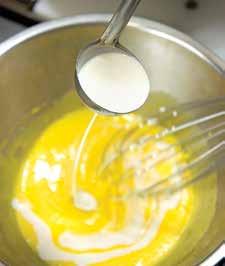
5 minute read
COOKING CLASS
Crèmebrûlée
there is something irresistible about cracking through the browned and brittle glaze of a perfectly caramelized crème brûlée. All at once you are a child again, shattering that skiff of ice on a frozen puddle. But here, the payoff – the velvety unctuousness of rich vanilla cream – is very grown up indeed. It is this startling contrast between crisp and creamy that makes crème brûlée, or “burnt cream” as English undergraduates still call it, such a perennial favourite. Despite its Gallic name, crème brûlée is actually a traditional English dessert, said to have originated at Trinity College Cambridge in the late 1600s. It still appears frequently on College menus. Given crème brûlée’s lengthy British lineage, we asked Patrick Venables, chef at Terra Nova Public House, to show us how to prepare this elegant classic. The restaurant, situated in the Pine River Valley at the base of the Niagara Escarpment, has become a gathering place for local gastronomes and hungry hikers since it opened in 2011. Everything about the place is local. Owner Anna Alonso says 90 per cent of the Public House’s clientele are regulars. “We have people coming in who have beer mugs here with their names on them,” she says.
In best English pub tradition, the Public House serves hearty, homecooked meals prepared as much as possible with locally sourced products. The menu changes daily to reflect the seasonal bounty. Even the chef is homegrown. Patrick did his training in Vancouver, but was raised in Hockley Valley, and worked as executive chef at Devil’s Pulpit Golf Club in Caledon and at Orangeville’s One99 before arriving in Terra Nova late last year.
“Upscale pub fare” is how Anna describes the food at the Public House. “There is something for everyone, whether you drop in for wings and a beer, or braised lamb shanks and a nice bottle of wine.” And ever since it opened, the restaurant has featured crème brûlée on its menu.
“It’s one of my favourite desserts,” Patrick says, “and it’s one of our most popular desserts.”
We asked Patrick to put a seasonal spin on this recipe by adding raspberries and infusing the cream with lavender, both of which are plentiful for much of the summer. Be sure to use lavender flowers (fresh or dried) that have not been sprayed. Your own garden or a neighbour’s are probably the best sources. Simply simmer the lavender in the cream for five minutes, then strain.
Good vanilla is also a must. Patrick uses pure vanilla extract, but the ne plus ultra is the bean itself. Just split the pod lengthwise with a sharp knife and scrape the seeds into the cream along with the lavender
Opinions differ on whether the dessert should be served hot or cold. It is important to chill the cream for at least four hours before sprinkling on the sugar and torching. The cold cream allows the shell to harden quickly. Serve immediately, or if you prefer, wait until it comes to room temperature.
Crème brûlée is usually served in individual ramekins, but it also presents beautifully in a single nine-inch round ovenproof dish. Some people are intimidated by the final step. You will need a blowtorch for this. Patrick uses a large propane-fuelled device, but smaller butane torches are available at most hardware or kitchen stores.
“This is always an impressive dessert to serve at a dinner party,” says Patrick. He recommends doing the final caramelizing right at the table. “It always makes for great conversation when you pull out the blowtorch.” ≈
cooking with patrick venables

Chef Patrick Venables suggests impressing guests by caramelizing crème brûlée at the dinner table.



Let me help you find
the house you’ll call
home, sweet home.
(519) 341-6060 christopherbol@ ronanrealty.com ingredients
1 vanilla pod or 2 tsp pure vanilla extract 2 cups whipping cream 3 tbsp dried or fresh lavender flowers ¼ cup granulated sugar for custard 6 tbsp granulated sugar for topping 6 large egg yolks 1 pint raspberries (optional) Preheat the oven to 350°F. If using a vanilla bean, split pod lengthwise and scrape seeds into the cream. Put cream, lavender and vanilla into a saucepan. Bring cream to the boiling point, lower heat and simmer gently for 5 minutes. Strain cream into a clean saucepan. Heat over medium until the cream just begins to bubble around the edges. Do not let boil.




While cream is heating, beat sugar and egg yolks together in a large heat-proof bowl until fluffy. Temper the egg mixture by very slowly whisking in a small amount of warm cream. Take your time so the yolks don’t scramble. Once the egg mixture is tempered, slowly whisk in the remaining cream. Place ramekins in a large roasting tray. Place a few raspberries in the bottom of six ½-cup ramekins (or four larger ones). Pour cream over the raspberries until ramekins are about two-thirds full.



Add hot water to the roasting tray until it reaches halfway up the sides of the ramekins. Place the tray in the centre of the oven and bake for 45 minutes until custards are just set and a bit wobbly in the middle. Allow to cool to room temperature. Refrigerate for 4 hours or overnight. Cover the surface of each with a generous tablespoon of sugar. Caramelize with a blowtorch until dark golden brown. Let stand for 10 minutes or longer. Serves 4 to 6. ≈












